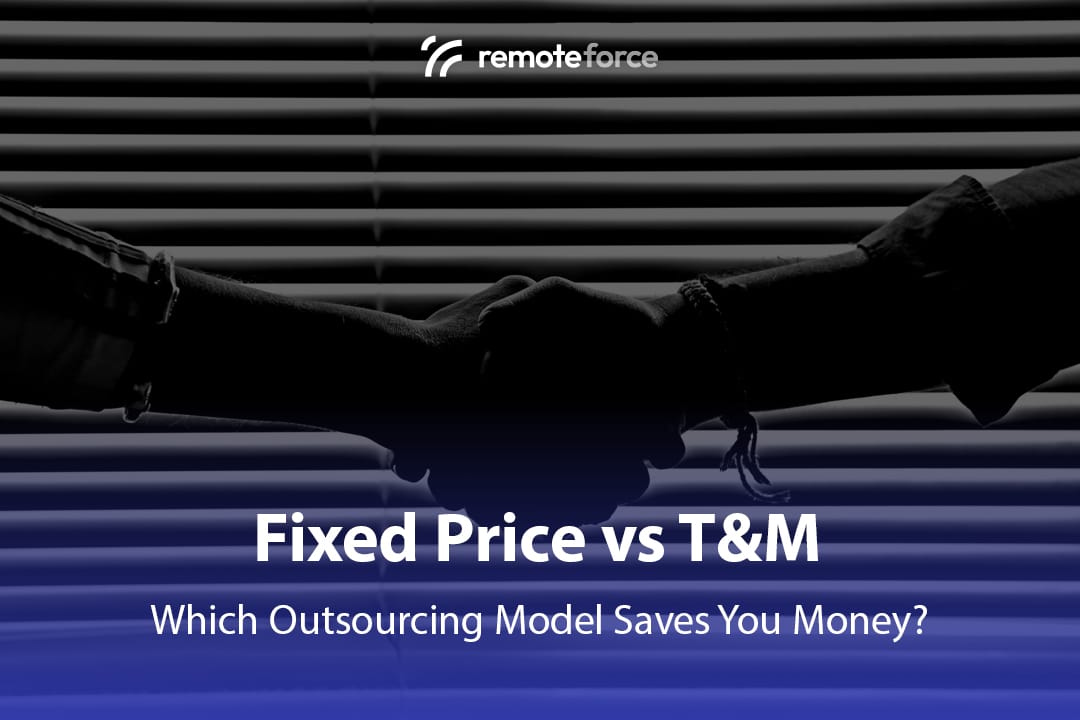When engaging a manpower outsourcing vendor for services like digital marketing, web development, or accounting support, one of the most crucial decisions you’ll make is choosing the right pricing model. The two most common models are Fixed Price (FP) and Time and Material (T&M).
Many businesses assume Fixed Price is inherently cheaper because the total cost is known upfront. However, the reality is far more complex. The true cost savings depend entirely on the project’s characteristics, your flexibility needs, and your appetite for risk.
This guide breaks down the financial dynamics of each model to help you determine which one genuinely saves you more money and delivers the best value for your specific needs.
Table of Contents
ToggleUnderstanding the Models: A Quick Review
Before diving into the savings analysis, let’s quickly define the two core models:
1. Fixed Price (FP) Model
- The Premise: A single, non-negotiable price is set for a clearly defined scope of work with specific deliverables and deadlines.
- Best for: Projects with minimal expected changes, such as a basic website launch, a one-time legal audit, or creating a set number of graphic assets.
- Vendor Risk: The vendor absorbs the risk of time overruns.
2. Time & Material (T&M) Model
- The Premise: You pay for the actual time spent by the outsourced personnel (hourly/daily rates) plus any pre-approved material costs (e.g., software licenses).
- Best for: Long-term partnerships, projects with evolving requirements (e.g., ongoing app maintenance, continuous digital marketing campaigns), or high-flexibility needs.
- Client Risk: The client absorbs the risk of time overruns.
When Fixed Price (FP) Saves You More
The Fixed Price model is a clear winner in scenarios where uncertainty is low and scope is rigid. It saves money primarily by transferring the risk of inefficiency to the vendor.
1. When the Scope is Rock-Solid
If your requirements document is exhaustive, detailed, and signed off on without expectation of change, FP is often cheaper. The vendor can accurately estimate the effort, and you avoid paying for surprise costs.
- Example: You need a specialized accounting system implemented with a defined number of integrations. The vendor knows exactly how long it will take and prices it competitively to win the deal.
2. When Speed is the Priority
Since the vendor has already locked in their revenue, they are incentivized to complete the project as fast as possible to maximize their profit margin. This drive for efficiency translates to a quicker time-to-market for you, which is a form of cost saving (opportunity cost).
3. When Budget Predictability is King
If hitting a specific budget cap is more critical than minor scope flexibility, FP offers complete financial certainty. This certainty prevents the dreaded cost escalation common in T&M models.
The Catch: Vendors often build a “risk buffer” into the Fixed Price to cover any unforeseen issues. If the project goes perfectly, this buffer is profit for the vendor—and an overpayment by the client.
When Time & Material (T&M) Saves You More
The T&M model unexpectedly saves money when flexibility is high and the scope is prone to change. This model is highly effective for strategic, long-term partnerships.
1. When Scope Creep is Inevitable
This is the single biggest area of T&M savings. In an FP contract, every minor change requires a formal, time-consuming, and often expensive Change Request (CR) negotiation, which the vendor can price at a premium. With T&M, the change is simply absorbed into the regular billing cycle at the same hourly rate.
- Financial Impact: Paying a standard T&M hourly rate for a new requirement is almost always cheaper than paying the vendor’s high markup on a Fixed Price change request.
2. When Project Requirements are Vague
For complex, multi-phase projects like app development or continuous digital marketing strategy, the true requirements only emerge as the project progresses. Starting with T&M means you only pay for the work actually needed and avoid paying a huge risk buffer that a Fixed Price vendor would have charged to cover the unknown.
3. When Efficiency Can Be Managed Internally
If you have a strong internal project manager overseeing the outsourced team (like a technical lead supervising a web developer), you can control the efficiency and resource allocation directly. You ensure that the team is always working on the highest-priority tasks, minimizing wasted hours.
4. When You Need Highly Specialized Talent
For niche roles (e.g., a certified legal compliance expert), the vendor might offer a slightly lower hourly T&M rate than they would charge for the enormous risk buffer required for a fixed-price engagement.
The True Comparison: Where Cost is Hidden
The table below illustrates the hidden financial impact of each model:
| Cost Factor | Fixed Price (FP) | Time & Material (T&M) |
|---|---|---|
| Initial Cost | Higher (Includes Risk Buffer) | Lower (Only Billed for Actual Time) |
| Cost of Scope Change | Very High (Expensive Change Requests) | Standard Hourly Rate (Minimal Friction) |
| Risk of Over-Budgeting | Low (Total known) | High (Requires strict client monitoring) |
| Risk of Poor Quality | High (Incentive to cut corners) | Low (Incentive to use best talent) |
| Cost of Delay | Absorbed by Vendor (Financial Risk to them) | Absorbed by Client (More hours billed) |
Strategic Conclusion: Which Model Should You Choose?
The question isn’t which model is universally cheaper, but which model fits your project risk profile.
| Project Scenario | The Smarter Choice for Savings | Why It Saves Money |
|---|---|---|
| Defined, Short-Term Tasks | Fixed Price | Eliminates budget risk and forces vendor efficiency on a known scope. |
| Ongoing, Complex, or Strategic | Time & Material | Saves money by eliminating expensive change request negotiations and risk buffers on evolving requirements. |
| Manpower Augmentation (Dedicated Staff) | Dedicated Team Model | For services like secretarial or RPO support, a fixed monthly rate guarantees dedicated focus and cost predictability. |
If your outsourcing need is a strategic, long-term partnership requiring flexibility and high-quality talent—like leveraging RemoteForce for continuous digital marketing or app development support—the T&M or Dedicated Team model typically offers the best long-term value and avoids the crippling costs of scope change.
Partnering with RemoteForce for Optimized Value
Understanding the nuances of pricing models allows you to negotiate a deal that aligns financial incentives with your business goals. Choosing an established and legally compliant vendor is the first step in ensuring any pricing model—Fixed Price, T&M, or Dedicated Team—is executed transparently and ethically.
At RemoteForce, we specialize in providing high-quality, certified manpower for demanding roles, including legal, accounting, and digital marketing. We guide you through the pros and cons of each pricing model, ensuring you select the structure that minimizes your risk and maximizes your ROI. Don’t let hidden costs derail your growth; partner with us for transparent and cost-effective outsourcing solutions.




